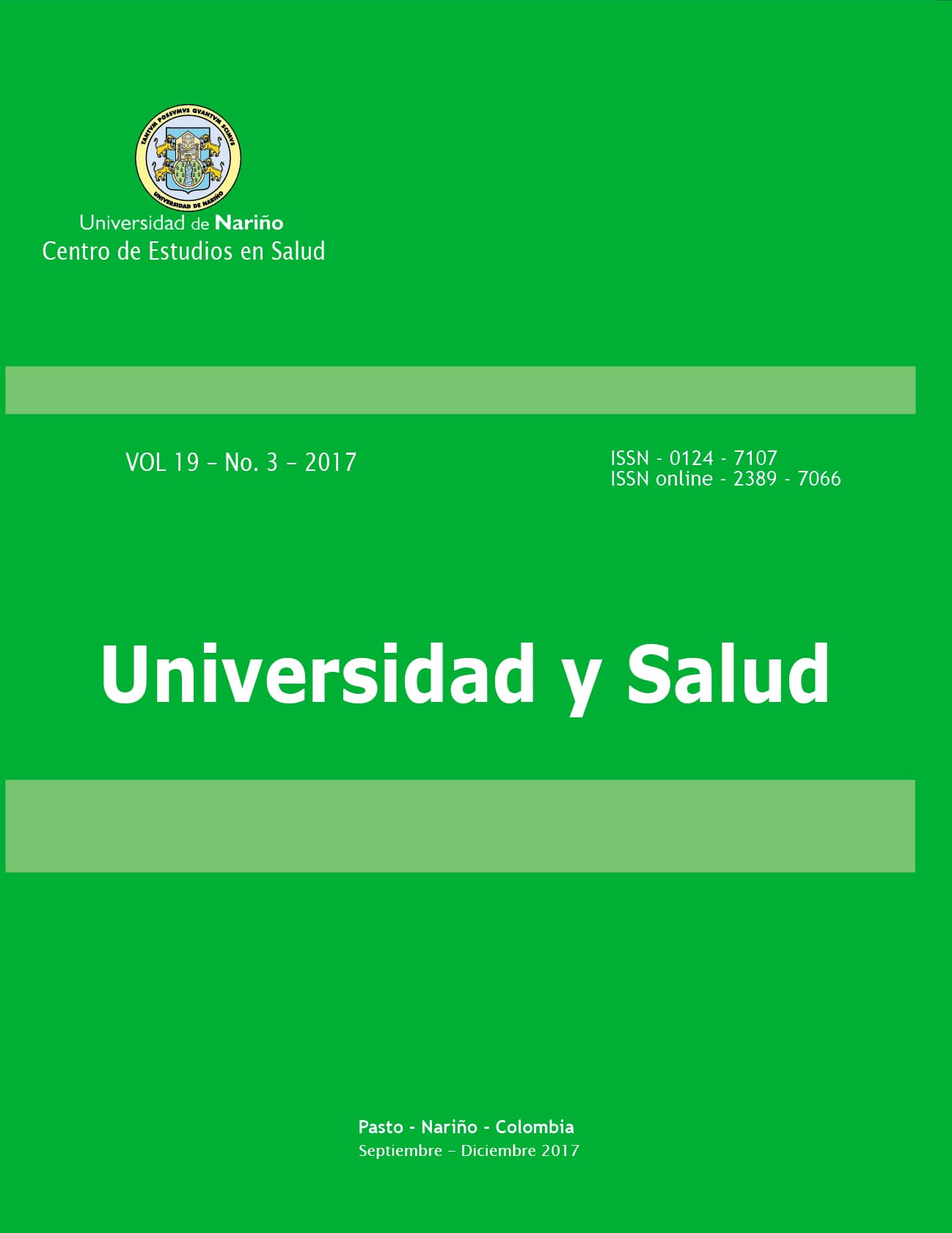Application of decision trees in the identification of patterns of fatal injuries by external cause in the municipality of Pasto, Colombia
DOI:
https://doi.org/10.22267/rus.171903.101Keywords:
Pattern recognition, automated, Datamining, Decision trees, ClassificationAbstract
Introduction: The Pan American Health Organization (PHO) and the World Health Organization (WHO) accepted, since the year 1993 and 1996 respectively, that violence is a public health problem, a situation that is corroborated in the report on violence and health, in which Latin America presented a homicide rate of 18 per 100,000 people, and it is considered one of the most violent regions in the world. Objective: To detect criminal patterns with data mining techniques in the Crime Observatory of the municipality of Pasto (Colombia). Materials and methods: Cross Industry Standard Process for Data Mining (CRISP-DM) was applied, which is one of the methodologies used in the development of data mining projects in academic and industrial environments. The source of information was the Crime Observatory of the municipality of Pasto, where the historical clean and transformed figures on the injuries of external cause (fatal and nonfatal) recorded in 11 years are stored. Results: A decision tree-based classification model was built that allowed the discovery of patterns of deaths from external causes. In the case of homicide, these happened mostly in the commune 5 in Pasto under the following circumstances: during the weekends, in the early morning, in the second semester of the year and in the public thoroughfare; besides, the victims were adult men of various professions; and the cause of the homicides were quarrels and they were produced with a fire gun. Conclusion: The generated knowledge will help government and security agencies make effective decisions regarding the implementation of crime prevention and citizen security plansDownloads
Metrics
References
Chen H, Chung W, Qin Y, Chau M, Xu JJ, Wang G, et al. Crime Data Mining : An Overview and Case Studies. Commun ACM. 2002;2:165-276.
Perversi I, Valenga F, Fernández F, Britos P, Garcia-Martinez R. Identificación y Detección de Patrones Delictivos basada en Minería de Datos. En: IX Workshop de Investigadores en Ciencias de la Computación; Trelew, Argentina 2007. Trelew: Red de Universidades con Carreras en Informática (RedUNCI); 2007. p. 385-9.
Schotborgh M, Laverde N, Valbuena Y, Blandón A. Protocolo de Vigilancia en Salud Pública: Lesión de Causa Externa. Bogotá: INS; 2016.
Instituto CISALVA. Sistematización de Experiencias sobre Sistemas de Vigilancia, Observatorios o Sistemas de Información de Violencia en América Latina. Cali,: Centro Editorial CATORSE SCS; 2009. 62 p.
Instituto CISALVA. Guía Metodológica para la Replicación de Observatorios Municipales de Violencia. Cali: Centro Editorial CATORSE SCS; 2008. 45 p.
Betancourt C. Vigilancia de lesiones de causa externa para la toma de decisiones en el nivel local, experiencia de Pasto, Colombia, 1 diciembre de 2004 - enero 15 de 2005. Inf Quinc Epidemiol Nac. 2005;10(12):177-92.
Valenga F, Fernández E, Merlino H, Procopio C, Britos P, Garcia-Martinez R. Minería de Datos Aplicada a la Detección de Patrones Delictivos en Argentina. En: VI Jornadas Iberoamericanas de Ingeniería de Software e Ingeniería del Conocimiento; Guayaquil, 2008. Guayaquil: Escuela Superior Politécnica del Litoral Facultad de Ingeniería Eléctrica y Computación Área de Ingeniería en Software VLIR -ESPOL Componente 8; 2008. p. 427.
Sentient. DataDetective Sentient Information Systems [Internet]. Ámsterdam: Sentient; 2012. Disponible en: http://sentient.nl/docs/ReleaseNotes_DataDetective2012_NL.pdf
Chen H, Chung W, Xu J, Wan G, Qin Y, Chau M. Crime Data Mining: A General Framework and Some Examples. IEEE Comput Soc. 2004;37(4):50-6.
Hauck R, Atabakhsh H, Ongvasith P, Gupta H, Chen H. Using Coplink to Analyze CriminalJustice Data. IEEE Comput. 2002;35:30-7.
Reza K, Javideh M, Reza E. Detecting and investigating crime by means of data mining: a general crime matching framework. Procedia Computer Science. 2011;3:872-80.
Valenga F, Perversi I, Fernández E, Merlino H, Rodríguez D, Britos P. Aplicación de Minería de Datos para la Exploración y Detección de Patrones Delictivos en Argentina. En: XIII Congreso Argentino de Ciencias de la Computación; Argentina, 2007. Argentina: Universidad Nacional del Nordeste; 2008. p. 1868.
Montt C, Rubio J, Lanata S. Análisis de accidentes de tránsito con Inteligencia Computacional. XVI Congreso Chileno de Ingeniería de Transporte. 2013;(16):1-11.
Azevedo A, Santos M. KDD, SEMMA and CRISP-DM: a parallel overview. In: IADIS European Conference on Data Mining. Amsterdam, Netherlands; 2008. p. 182-5.
Timaran R, Baron A, Hernàndez G, Arsenio H, Betancourth C. SIGEODEP: Un primer paso para la Detección de Patrones Delictivos con Técnicas de Minería de Datos. In: Pow-Sang JA, Melgar A, editors. IX Jornadas Iberoamericanas de Ingeniería de Software e Ingeniería del Conocimiento. Lima, Perú: Pontificia Universidad Católica del Perú; 2012. p. 87-94.
Timaran R, Calderón A, Hidalgo A, Baron A, Hernández G. Construcción de un mercado de datos para el almacenamiento de lesiones de causa externa. Vent Inform. 2014;30:67-79.
Gallardo J. Metodología para el Desarrollo de Proyectos en Minería de Datos CRISP-DM. [Internet]. 2009. Disponible en: http://www.oldemarrodriguez.com/yahoo_site_admin/assets/docs/Documento_CRISP-DM.2385037. pdf
Waikato. Weka 3: Data Mining Software in Java [Internet]. Nueva Zelanda: Machine Learning Group at the University of Waikato. Disponible en: http://www.cs.waikato.ac.nz/ml/weka/
Han J, Kamber M. Data Mining: Concepts and Techniques. San Francisco, USA: Morgan Kaufmann Publishers; 2001. 550 p.
Sattler K, Dunemann O. SQL Database Primitives for Decision Tree Classifiers. In: Paques H, Liu L, Grossman D, editors. The 10th ACM International Conference on Information and Knowledge Management. Atlanta, USA: ACM New York; 2001. p. 379-86.
Villena J. CRISP-DM: La metodología para poner orden en los proyectos de Data Science. [Internet]. 2016. Disponible en: https://data.sngular.team/es/art/25/crisp-dm-la-metodologia-para-poner-orden-en-los-proyectos-de-data-science
Hernández J, Ramírez M, Ferri C. Introducción a la Minería de Datos. Fayerman D, editor. Madrid: Pearson Prentice Hall; 2004. 680 p.
García M, Álvarez A. Análisis de Datos en WEKA -Pruebas de Selectividad [Internet]. Disponible en: http://www.it.uc3m.es/jvillena/irc/practicas/06-07/28.pdf
Witten I, Frank E. Data Mining: Practical Machine Learning Tools and Techniques with Java Implementations. San Francisco: Morgan Kaufmann Publishers; 2000. 365 p.
Campbell S, Quintero M. Comportamiento de las lesiones fatales de causa externa en Florencia. Acta Médica Colombiana. 1997;22(4):161-166.
Moya D. Comportamiento de lesiones de causa externa, Colombia, 2013. Bogotá: Instituto Nacional de Medicina Legal y Ciencias Forenses.
Organización Panamericana de la Salud. La Salud en las Américas Edición 2002 Volumen I. Washington: OPS; 2002. 473 p.
Ministerio de Salud de la Nación. Lesiones por causa externa. En: Informe de resultados Segunda Encuesta Nacional de Factores de Riesgo. Buenos Aires: Ministerio de Salud; 2009. p. 182-225.
World Health Organization. The Global Burden of Disease 2004 update. Geneve: WHO; 2008. 160 p.
Organización Panamericana de la Salud. La Salud en las Américas Edición 2012 Volumen de Países: Colombia. Washington: OPS; 2012.
Published
How to Cite
Issue
Section
License
Copyright (c) 2017 Universidad y Salud

This work is licensed under a Creative Commons Attribution-NonCommercial-ShareAlike 4.0 International License.



















